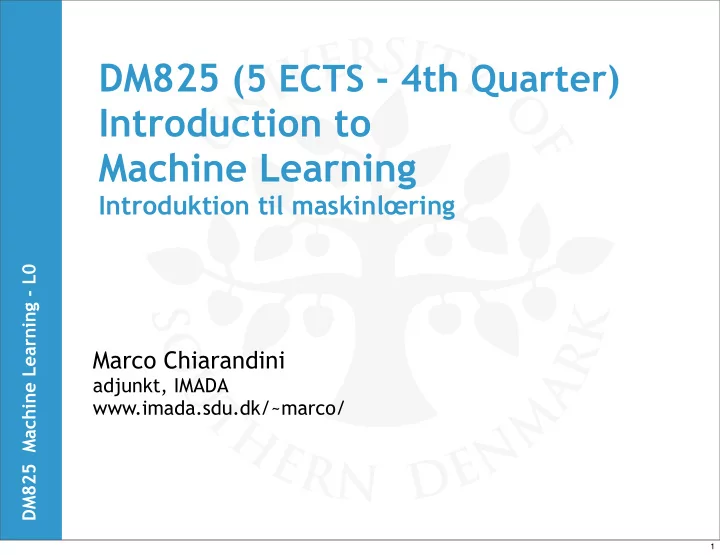

DM825 (5 ECTS - 4th Quarter) Introduction to Machine Learning Introduktion til maskinlœring DM825 Machine Learning - L0 Marco Chiarandini adjunkt, IMADA www.imada.sdu.dk/~marco/ 1
Machine Learning A computer program is said to learn from experience E with respect to some class of tasks T and performance measure P, if its performance at tasks in T, as measured by P, improves with experience E. Tom M. Mitchell (1997) Machine Learning p.2 DM825 Machine Learning - L0 2
Machine Learning A computer program is said to learn from experience E with respect to some class of tasks T and performance measure P, if its performance at tasks in T, as measured by P, improves with experience E. Tom M. Mitchell (1997) Machine Learning p.2 DM825 Machine Learning - L0 Core objective of a learner: generalize from its experience. Training examples from experience come from unknown probability distribution. The learner has to extract something to produce a useful answer in new cases. 2
Contents ‣ Classification and Regression via Linear Models ‣ Neural Networks ‣ Graphical Models Bayesian Networks Hidden Markov Models DM825 Machine Learning - L0 ‣ Mixture Models and Expectation Maximization ‣ Support Vector Machines ‣ Assessment and Selection ‣ Unsupervised Learning (Association rules, cluster analysis, principal components) 3
DM825 Machine Learning - L0 Perceptron algorithm 4
Multilayered Neural Networks DM825 Machine Learning - L0 5
DM825 Machine Learning - L0 Applications 6
Applications Handwritten digit recognition DM825 Machine Learning - L0 Humans are at 0.2% – 2.5 % error 400–300–10 unit MLP = 1.6% error LeNet: 768–192–30–10 unit MLP = 0.9% error 7
Graphical Models Allow to represent our prior knoweldge and to use a general suite of algorithms to make inference and to improve our models for a specific application domain DM825 Machine Learning - L0 Complex systems involve uncertainty => Probability framework interralated aspects of the system are modelled as random variables 8
Example: Medical diagnosis • two deases: Fly and Hayfever • they are not mutually exclusive • Season might be correlated with them • symptoms such as Congestion and Muscle Pain DM825 Machine Learning - L0 4 random variables: Flu = {true,false}; Hayfever = {true, false} Season = {fall, winter, spring, summer} 2x2x4x2x2=64 Congestion = {true, false} possible prob. values for joint distribution MusclePain = {true, false} P(Flu=true | Season=fall, Congestion=true, MusclePain=false) If the number of variables grows the problem becomes intractable 9
Example: continued Graphical models use graph-based representation to encode independencies Season Flu Hayfever DM825 Machine Learning - L0 MusclePain Congestion F and H independent given Season C and S independent given F and H We thus only need to define M and H,C independent given F 3+ 4 +4 +4 +2 =17 parameteers M and C independent gien F P(S,F,H,C,M)=P(S)P(F|S)P(H|S)P(C|F,H)P(M|F) 10
Bayesian Learning What can we do from here? • Inference: Complexity issues O(2^n) • Learning (parameters and structure) DM825 Machine Learning - L0 11
Bayesian Learning What can we do from here? • Inference: Complexity issues O(2^n) • Learning (parameters and structure) Thumbtack Experiment DM825 Machine Learning - L0 11
Bayesian Learning What can we do from here? • Inference: Complexity issues O(2^n) • Learning (parameters and structure) Thumbtack Experiment Flip the thumbtack in the air and observe the DM825 Machine Learning - L0 number of times it lands with head and tail We wish to learn how much the probability deviates from 0.5 11
Bayesian Learning What can we do from here? • Inference: Complexity issues O(2^n) • Learning (parameters and structure) Thumbtack Experiment Flip the thumbtack in the air and observe the DM825 Machine Learning - L0 number of times it lands with head and tail We wish to learn how much the probability deviates from 0.5 11
Bayesian Learning What can we do from here? • Inference: Complexity issues O(2^n) • Learning (parameters and structure) Thumbtack Experiment Flip the thumbtack in the air and observe the DM825 Machine Learning - L0 number of times it lands with head and tail We wish to learn how much the probability deviates from 0.5 Suppose we observe 3 heads in 10 tosses. • With no prior knowledge we would set p=3/10=0.33 • With a prior of 10 heads over 20 tosses we would set p=(3+10)/ (10+20)=13/30=0.43 • However if we obtain more data the effect diminshes: (300+1)/1000+2=0.3 and (300+10)/(1000+20)=0.3 11
Course Organization Prerequisites ✓ MM501 Calculus I ✓ MM505 Linear Algebra ✓ Basics of Probability Calculus DM825 Machine Learning - L0 Final Assessment (5 ECTS) ‣ Mandatory assignments, pass/fail, internal evaluation by the teacher. Include programming work in R ‣ 3 hours written exam, Danish 7 mark scale ‣ External examiner 12
Course Material ‣ Text book - C.M. Bishop. Pattern recognition and Machine Learning Springer, 2006 - Slides ‣ Source code and data sets DM825 Machine Learning - L0 ‣ www.imada.sdu.dk/~marco/DM825 13
Recommend
More recommend